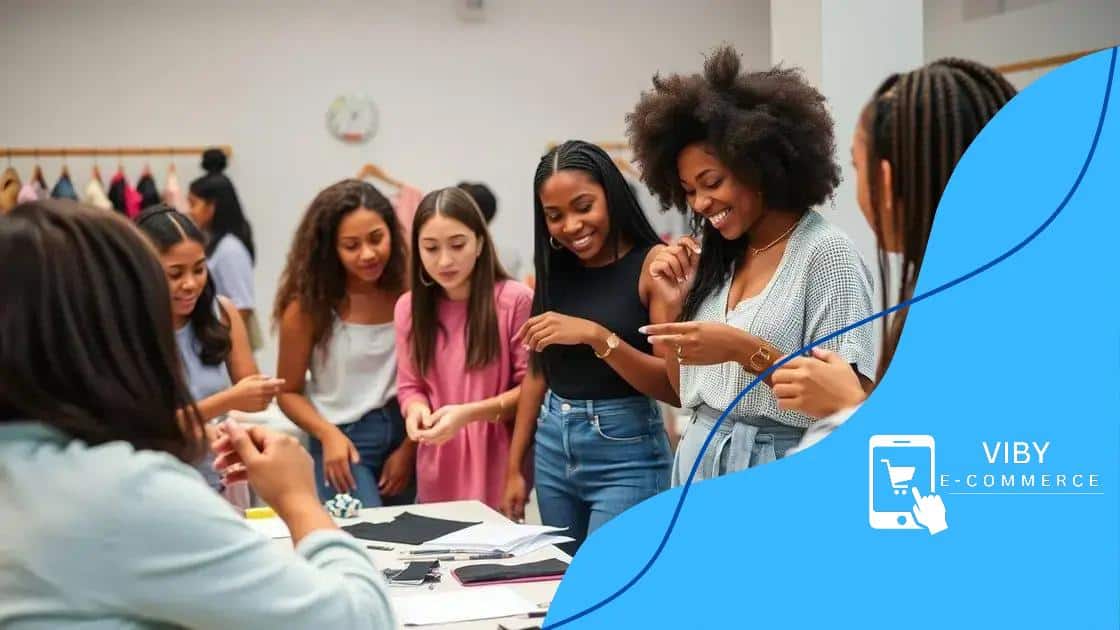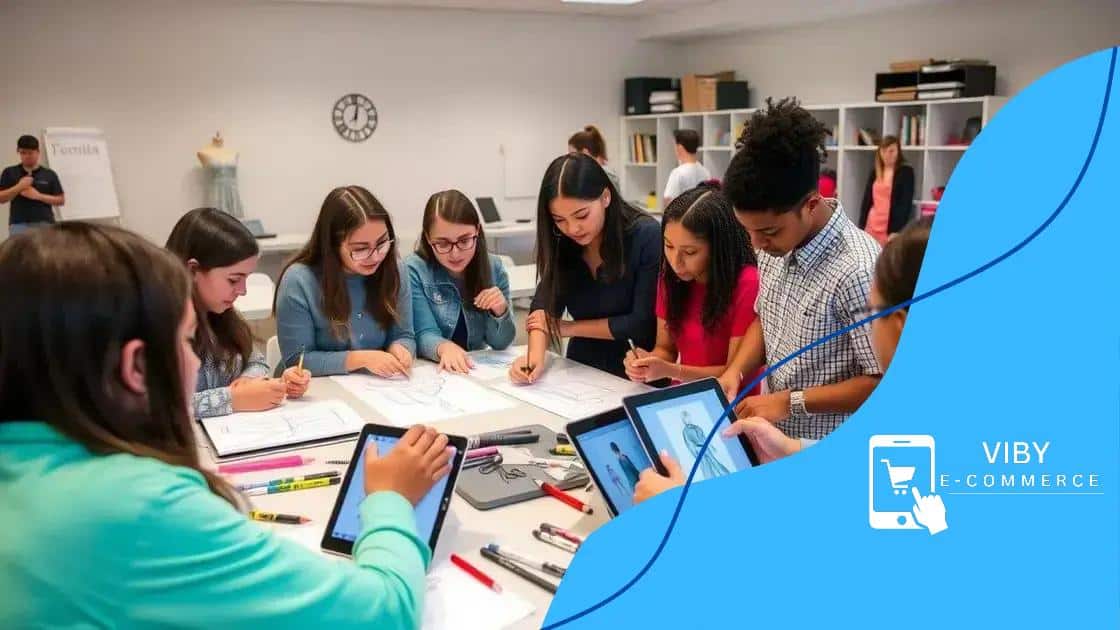How Shein promotes inclusivity through fashion education

How Shein promotes inclusivity through fashion education involves empowering diverse students, integrating technology for immersive learning, and fostering collaborations to ensure that all voices are represented in the fashion industry.
How Shein promotes inclusivity through fashion education is shaping the industry by bridging gaps and inspiring underrepresented voices. Have you wondered how a brand can create a space where everyone feels seen and valued? Let’s dive into their approach and explore the possibilities.
The role of fashion education in promoting inclusivity
The role of fashion education in promoting inclusivity is crucial for shaping a diverse and welcoming industry. By providing opportunities for underrepresented individuals, fashion education helps break down barriers and foster creativity. Educational programs are now focusing on celebrating different backgrounds and perspectives, making fashion accessible to everyone.
The Importance of Diverse Perspectives
Diverse perspectives in fashion education enrich the learning experience. When students from various backgrounds share their stories and styles, it allows for a broader understanding of fashion as an art form. This exchange nurtures creativity and encourages innovation.
- Encouraging collaboration among students
- Highlighting unique cultural influences
- Creating inclusive fashion narratives
Furthermore, educational institutions are beginning to embrace inclusive curricula. Inclusion in fashion education can take many forms, from showcasing designs that reflect various cultures to teaching students about the importance of size diversity in models. By doing this, schools and colleges equip students with the necessary skills to engage with a diverse clientele in the professional world.
Practical Initiatives
Several organizations are taking action through workshops and mentorship programs that support aspiring fashion designers from all walks of life. These initiatives create pathways to success by:
- Offering grants for diverse fashion students
- Facilitating internships with inclusive brands
- Connecting students with role models in the industry
With such practical initiatives, fashion education not only promotes skills but also inspires future designers to create inclusive collections. When students graduate, they have a heightened awareness of the importance of representation, ready to challenge conventions in the fashion world.
Shein’s initiatives for diverse representation in fashion
Shein’s initiatives for diverse representation in fashion serve as a vital step toward creating an inclusive environment in the industry. By recognizing the need for representation, Shein focuses on ensuring that voices from different backgrounds are heard and celebrated. This effort not only reflects a commitment to diversity but also empowers consumers to feel connected to the brand.
Inclusive Campaigns and Collaborations
One way Shein promotes diversity is through its inclusive campaigns. These campaigns showcase models from various ethnicities and body types. By doing this, Shein sends a strong message that fashion is meant for everyone, regardless of size, shape, or background.
- Feature diverse models in advertisements
- Collaborate with influencers from various communities
- Highlight unique cultural designs in product lines
Moreover, Shein has partnered with various organizations that focus on social impact. These collaborations ensure that the brand plays an active role in supporting causes that promote diversity. Schools and community centers benefit from fashion programs sponsored by Shein, providing resources and mentorship to aspiring designers.
Empowering Creative Voices
By investing in programs that highlight diverse stories, Shein encourages students from various backgrounds to share their creativity. Through contests and workshops, participants can showcase their designs and express their unique perspectives.
- Encouraging the development of original fashion collections
- Providing scholarships for underrepresented students
- Offering platforms for young designers to present their work
Such initiatives not only inspire future generations but also help shape the narrative around fashion. The aim is to create an industry where everyone feels represented and valued, ultimately leading to richer and more innovative designs.
Collaborations with educators and designers for inclusivity

Collaborations with educators and designers for inclusivity are essential for fostering a diverse and creative fashion industry. These partnerships aim to integrate diverse viewpoints and talents, ensuring that the fashion space welcomes everyone’s unique contributions. By bringing together educators and industry professionals, we can help shape a more inclusive future.
Connecting Education and Industry
Fashion educators play a significant role in preparing students to enter the industry. Collaborating with renowned designers helps enhance the curriculum, making it more relevant and diverse. Guest lectures, workshops, and mentorship programs allow students to learn directly from those who have made their mark in the fashion world.
- Encouraging real-world experience through internships
- Providing insights into best practices and trends
- Sharing resources for diverse design techniques
This connection not only enriches students’ learning experiences but also ensures that future designers understand the importance of inclusivity in their work. Graduates who emerge from these programs are more equipped to create collections that resonate with a broader audience.
Building Bridges for Creative Voices
Moreover, collaborations often lead to exciting projects that highlight diverse talents. Fashion shows featuring collections from students and emerging designers showcase creativity and innovation. These events celebrate inclusivity by featuring models and styles that represent different cultures.
- Showcasing student design projects to the public
- Offering scholarships for diverse design students
- Creating opportunities for networking within the industry
Such initiatives inspire and empower the next generation of fashion designers. As they collaborate with experienced professionals, students gain the confidence to express their unique identities through their designs. This dynamic interaction between education and industry drives the evolution of fashion toward a more inclusive landscape.
Real stories of impact: students and communities
Real stories of impact showcase how fashion education transforms students and communities alike. These narratives highlight the experiences of individuals who have benefited from inclusivity in fashion programs. Each story not only celebrates achievements but also emphasizes the profound changes these initiatives bring to people’s lives.
Empowerment Through Education
Students from diverse backgrounds often find empowerment through education in fashion. Many have shared how programs that prioritize inclusivity opened doors for them. For example, one student began her journey unsure of her place in the industry.
- Received mentorship from experienced designers
- Participated in workshops that explored cultural designs
- Gained confidence to showcase her unique voice
Her story represents many others who have transformed their skills into successful careers. Their narratives inspire new students to pursue their passions in fashion.
Community Engagement and Growth
The impact of these programs extends beyond individual students to entire communities. Fashion initiatives often collaborate with local organizations to host events that promote inclusivity.
- Organizing community fashion shows to celebrate diversity
- Providing resources for aspiring designers in underserved areas
- Establishing partnerships with local artisans to boost creativity
These events not only showcase talent but also build a sense of belonging. They create spaces where individuals from all walks of life can connect through their love for fashion. The ripple effect of these stories is seen in thriving communities eager to support their local creatives.
As more students rise through these programs, the narrative of inclusivity in fashion continues to expand. Each story contributes to a larger movement that aims to shift the industry’s focus towards embracing all voices.
Future trends in inclusive fashion education
Future trends in inclusive fashion education are set to reshape how we think about diversity in the industry. As the landscape evolves, educational institutions and industry professionals are starting to recognize the importance of inclusivity in their programs. This shift aims to prepare students for a global market that values representation and accessibility.
Embracing Technology in Learning
One of the most promising trends is the integration of technology in fashion education. Virtual reality (VR) and augmented reality (AR) are being used to create immersive learning experiences. Students can interact with diverse design elements from cultures worldwide, allowing for a deeper understanding of inclusivity.
- Using VR to simulate real-world fashion shows
- AR for hands-on design experience
- Online platforms for global collaboration
This innovative approach not only makes learning more engaging but also exposes students to various global styles and perspectives. Technology is breaking down traditional barriers in education, opening the door for every voice to be heard.
Curricula Focused on Diversity
Another key trend is the push for more comprehensive curricula that reflect diverse backgrounds. Educational institutions are starting to include courses that explore cultural influences in fashion, ethics in design, and the history of marginalized groups in the industry. This deeper understanding fosters a sense of awareness and responsibility among students.
- Integrating cultural studies into fashion programs
- Encouraging equity and sustainability discussions
- Highlighting contributions from underrepresented designers
By addressing these topics, fashion education can create not just skilled designers but also socially conscious individuals who understand the impact of their work.
As these trends gain momentum, the future of fashion education looks bright and inclusive. Students will be better equipped to navigate a changing industry while promoting diversity, empathy, and innovation in their designs.
FAQ – Frequently Asked Questions about Inclusivity in Fashion Education
What is the focus of inclusive fashion education?
Inclusive fashion education aims to empower students from diverse backgrounds, ensuring that all voices are represented in the fashion industry.
How does technology enhance fashion education?
Technology like virtual reality (VR) and augmented reality (AR) provides immersive learning experiences, allowing students to explore diverse designs and cultures.
What initiatives promote diversity in fashion programs?
Many fashion programs collaborate with local designers and community organizations to create workshops, scholarships, and mentorship opportunities for underrepresented students.
Why is representation important in fashion education?
Representation fosters creativity and innovation, allowing future designers to draw inspiration from a wide range of cultural perspectives and experiences.





